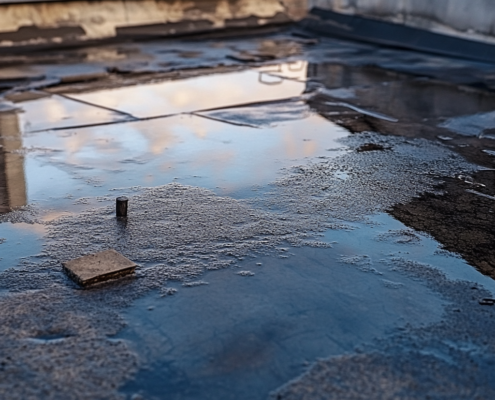Understanding Flat Roof Slope: Why It’s Crucial for Roofing Performance
When planning or maintaining a flat roof, one key consideration is the flat roof slope. Although flat roofs appear to be completely horizontal, they require a slight slope to ensure proper drainage. Without it, water can pool on the surface, leading to potential leaks, roof degradation, and costly repairs. In this article, we’ll dive into why flat roof slope is essential, how to design it correctly, and the factors that affect its effectiveness.
What is Flat Roof Slope?
A flat roof slope refers to the slight angle designed into a seemingly flat roof to ensure water flows off the surface rather than accumulating in pools. Unlike pitched roofs, which naturally shed water due to their steep angle, a flat roof slope uses minimal tilt to guide rainwater or melted snow towards drains or gutters. This slope is typically achieved by adding a gradient during construction or using materials that support drainage flow.
Flat roofs are commonly found on commercial buildings, garages, and modern homes due to their sleek, minimalist appearance. However, achieving the right slope is crucial to ensure longevity and performance.
Why is Flat Roof Slope Important?
A flat roof slope plays a crucial role in:
- Preventing Water Pooling: The primary reason for adding a slope is to avoid water pooling on the roof. Standing water can cause structural damage and promote the growth of mold or algae, which degrade the roof’s surface.
- Extending Roof Lifespan: Proper drainage helps prevent leaks and moisture damage, ultimately extending the lifespan of the roofing materials. It reduces the chances of water seeping into the building and causing internal damage.
- Meeting Building Codes: Many municipalities have specific building codes for flat roof construction, which include requirements for minimum slopes to ensure adequate drainage. These regulations help maintain the safety and durability of the roof.
- Improved Aesthetics: A roof with the proper slope has a cleaner, more professional look. While flat roofs are often desired for their modern design, a slight slope is hardly noticeable but still effective for water management.
How Much Slope is Needed for a Flat Roof?
The flat roof slope doesn’t need to be as steep as a pitched roof, but it’s essential to get it right. Generally, a slope of 1/4 inch to 1/2 inch per foot is recommended. This translates to a slight incline of around 2% to 3%. For instance, for every 12 feet of horizontal roof space, there should be a rise of 3 to 6 inches.
However, there are variations depending on:
- Roof Material: Some materials, like EPDM (rubber roofing), may require a steeper slope for better drainage. On the other hand, built-up roofs (BUR) can sometimes work with a gentler slope.
- Climate: Areas with heavy snowfall or frequent rain may need a steeper slope to help water and snow slide off more effectively.
- Roof Design: The layout and size of the roof may also dictate the ideal slope. Larger roofs or those with multiple sections may require additional design considerations.

Water pooling on a flat roof due to insufficient slope can lead to serious roof damage and costly repairs.
Factors Affecting Flat Roof Slope Design
Several factors can affect the proper slope of a flat roof. Let’s take a closer look at some of them:
Roof Size and Shape
Larger roofs may need multiple slopes or a more complex design to ensure efficient drainage. Complex roof shapes with ridges or valleys might require specialized drainage solutions to avoid water pooling.
Material and Membrane Choices
The roofing material plays an essential role in the effectiveness of the slope. Materials like PVC or TPO membranes can provide better drainage when combined with an adequate slope, while others like modified bitumen may need additional waterproofing considerations.
Drainage System
A high-quality drainage system is a key component of any flat roof. Proper placement of drains, scuppers, or gutters ensures that water flows off the roof efficiently. Even with the right flat roof slope, a poorly designed or clogged drainage system will hinder performance.
Roof Structure
The underlying structure of the building can also affect the slope. Some flat roofs may require adjustments to the deck, framing, or supports to achieve the necessary gradient without compromising the integrity of the building.
How to Achieve the Correct Flat Roof Slope
Achieving the correct slope during installation or repair is crucial to ensure water flows off the roof efficiently. There are a few methods to achieve the ideal flat roof slope:
- Tapered Insulation: This is one of the most common methods for creating a slope. Tapered insulation panels are installed to form a gradient that directs water toward the drains. These panels come in various thicknesses, allowing for a custom slope to meet specific needs.
- Built-Up Roofing (BUR): In a BUR system, layers of asphalt and felt are built up to create a slope. The number of layers can be adjusted to ensure that water moves properly off the surface.
- Poured Concrete: For some commercial projects, poured concrete may be used to form the slope, providing a highly durable surface for water drainage.
- Roofing Membranes: Some flat roofs are designed with sloped roofing membranes, such as EPDM or TPO. These membranes can be shaped to guide water flow.
- Adjusting Roof Deck: In some cases, the roof structure itself can be adjusted to create a slope by altering the angle of the roof deck.
What Happens if a Flat Roof Does Not Have Proper Slope?
Without the correct flat roof slope, there are several risks:
- Water Damage: Pooling water on the roof can lead to leaks that compromise the building’s structure.
- Roof Degradation: Stagnant water can break down roofing materials, leading to premature failure of the roof.
- Mold and Algae Growth: Excess water can encourage the growth of mold and algae, which may spread onto walls or ceilings and create health concerns.
- Increased Repair Costs: Failure to maintain an adequate slope may result in more frequent repairs and higher maintenance costs.
Maintenance Tips for Flat Roofs
Even if your flat roof has the ideal slope, regular maintenance is essential to ensure long-term performance:
- Clear Debris: Ensure gutters, drains, and scuppers are free of leaves, branches, and other debris.
- Inspect Regularly: Conduct inspections twice a year, particularly after heavy rain or snowfall, to ensure water drains effectively.
- Check for Ponding: After a rainstorm, check the roof for areas of ponding, which may indicate insufficient slope or clogged drains.
- Perform Repairs Promptly: Address any leaks, cracks, or signs of wear as soon as possible to prevent further damage.
Frequently Asked Questions (FAQ)
1. What is the minimum slope required for a flat roof?
The minimum slope for a flat roof should be 1/4 inch per foot, which is approximately a 2% slope. This ensures that water can flow off the surface rather than pooling.
2. Can I install a flat roof without a slope?
No, a flat roof without a slope is prone to water accumulation, leading to leaks and other water-related issues. Even a slight slope is necessary to ensure proper drainage.
3. How do I know if my flat roof slope is correct?
A professional roofing contractor can assess your flat roof and determine whether the slope is sufficient. If water tends to pool on the roof, it may indicate that the slope needs adjustment.
4. What are the signs that my flat roof slope is not functioning properly?
The most common signs are water pooling, leaks inside the building, or visible signs of roof degradation, such as cracking or bubbling of roofing materials.
5. How much does it cost to fix a flat roof slope?
The cost can vary depending on the size of the roof, the materials used, and the complexity of the repair. Tapered insulation or adjusting the roof deck may add additional costs to the project.
6. Can I modify my existing flat roof to add slope?
Yes, it’s possible to retrofit a flat roof with additional slope through methods like installing tapered insulation, adjusting the roof structure, or adding a new membrane system.
Final Thoughts
A flat roof slope is a fundamental aspect of roof design that ensures the longevity, efficiency, and safety of your building. While flat roofs may seem simple, achieving the right slope is crucial for drainage and overall roof health. Whether you are designing a new roof or maintaining an existing one, consider working with a professional to ensure proper slope and drainage solutions.







